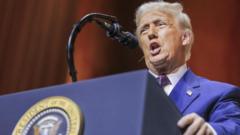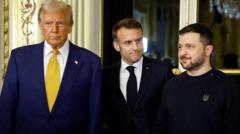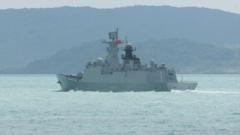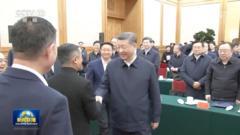Negotiations have resulted in a temporary 30-day reprieve for tariffs on goods exported from Mexico and Canada, while a 10% tariff on Chinese imports has commenced, underscoring the ongoing trade tensions between the U.S. and its partners.
**Trade Tensions Ease: Trump Postpones Tariffs on North America**

**Trade Tensions Ease: Trump Postpones Tariffs on North America**
President Trump, alongside the leaders of Mexico and Canada, has struck a last-minute deal to delay further tariffs.
The recent trade negotiations have marked a significant moment in U.S. international relations, particularly regarding its North American partners. President Trump managed to broker last-minute agreements with Mexican President Claudia Sheinbaum and Canadian Prime Minister Justin Trudeau, allowing a suspension of looming tariffs on goods from both nations. This decision comes as a protective measure against what Trump cites as rampant drug smuggling and illegal immigration issues.
The situation reflects a broader strategy of utilizing tariffs as leverage within diplomatic discussions, particularly given that over one-third of U.S. imports come from Mexico, Canada, and China. Tariffs have already been imposed on Chinese imports, with a further escalation anticipated in relations with the European Union, as Trump has signaled that tariffs against EU goods are forthcoming due to perceived trade imbalances concerning both auto and agricultural products.
These developments present a dual-edged sword; while there are potential gains for the U.S. economy, there are significant risks and costs associated with such aggressive policies. Economists caution that excessive reliance on tariffs might lead to retaliation and trade wars, impacting global market dynamics negatively.
The broader implications of Trump's trade policy extend beyond North America; it is being closely watched by allies and adversaries alike, including China. As Trump navigates the international landscape, reactions from various governments—like the ambiguity in China's strategy toward Trump’s policies—are pivotal to understanding future trade outcomes.
Critics and proponents alike are assessing the ramifications of these decisions, situating them within the context of a shifting geopolitical and economic landscape.
The situation reflects a broader strategy of utilizing tariffs as leverage within diplomatic discussions, particularly given that over one-third of U.S. imports come from Mexico, Canada, and China. Tariffs have already been imposed on Chinese imports, with a further escalation anticipated in relations with the European Union, as Trump has signaled that tariffs against EU goods are forthcoming due to perceived trade imbalances concerning both auto and agricultural products.
These developments present a dual-edged sword; while there are potential gains for the U.S. economy, there are significant risks and costs associated with such aggressive policies. Economists caution that excessive reliance on tariffs might lead to retaliation and trade wars, impacting global market dynamics negatively.
The broader implications of Trump's trade policy extend beyond North America; it is being closely watched by allies and adversaries alike, including China. As Trump navigates the international landscape, reactions from various governments—like the ambiguity in China's strategy toward Trump’s policies—are pivotal to understanding future trade outcomes.
Critics and proponents alike are assessing the ramifications of these decisions, situating them within the context of a shifting geopolitical and economic landscape.



















